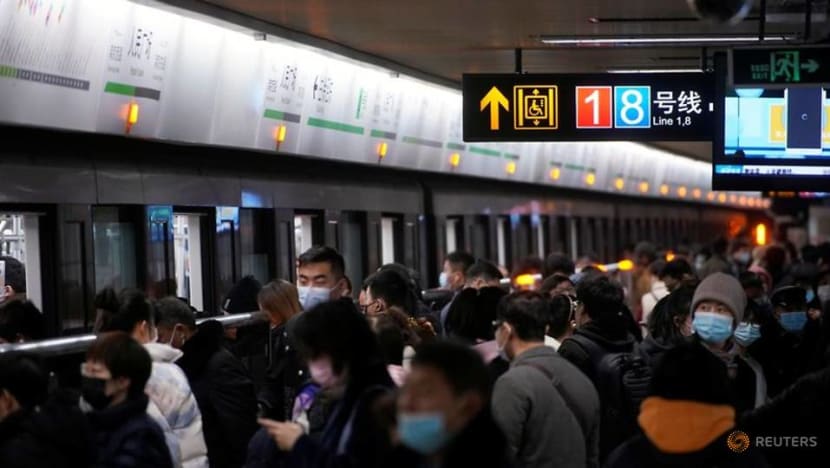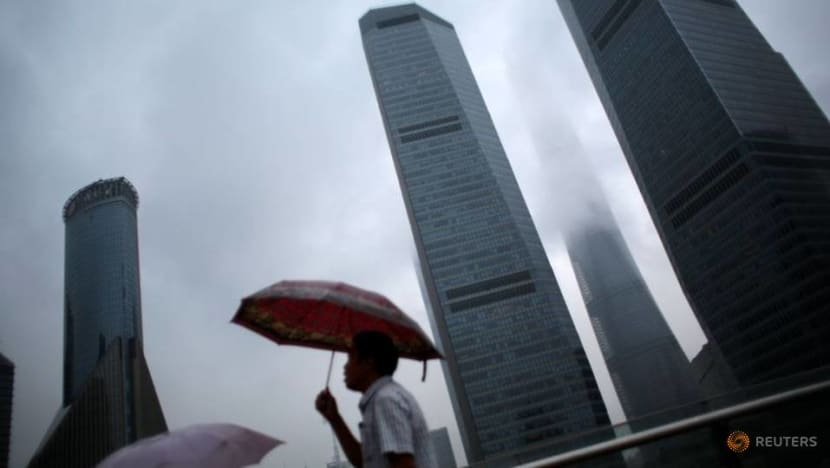commentary Commentary
Commentary: China has yet to reap the benefits of remote working
Compared to their New York counterparts, Shanghai residents pay as much for housing, but work far longer for much less pay. Telecommuting could make all the difference, says this economist.

FILE PHOTO: People wearing face masks wait to board a train at a subway station following the coronavirus disease (COVID-19) outbreak, in Shanghai, China January 14, 2021. REUTERS/Aly Song
CHICAGO: Before the pandemic, firms and workers around the world used emails and conference calls to reduce communication costs. But a lack of coordination made using these technologies fully difficult.
Firing off an email was easy, but there was no guarantee of when the other person would respond. People were reluctant to break old habits. Holding a virtual meeting might be interpreted by participants to mean that the topic wasn’t particularly important.
More broadly, low demand discouraged product development, leaving much to be desired in many workplace apps.
READ: Commentary: Five pandemic lessons we have learnt that should tide us over any surge in cases
By forcing entire economic sectors into virtual work, the COVID-19 pandemic has resolved many of these earlier coordination problems. Everyone in these sectors has had to invest in new technologies and learn how to use them.
And with everyone in the same boat, there is no longer any risk that a virtual meeting will be interpreted in a negative light. Better yet, workplace apps are becoming more user-friendly with every passing week.
In the United States, companies such as Google and government agencies such as the Federal Reserve have embraced virtual workplaces and announced that a significant number of their employees will continue to work remotely after the pandemic.
This makes sense: Companies lower their real-estate overhead, and employees gain more flexibility in their work schedules and choice of where to live. Moreover, fewer commuters imply less air pollution and urban congestion.
READ: Commentary: Why employers should cover WFH expenses
NO SHIFT TO VIRTUAL WORK IN CHINA
By contrast, in China, many sectors have been able to function relatively normally over the past year. As a result, there has been neither a wholesale shift to virtual work nor much discussion of new workplace models for the post-pandemic era.
Paradoxically, the benefits that China risks foregoing would be even more advantageous for its economy than for those of the US or Europe.

For example, virtual technologies can reduce the cost of living for many workers. Raising children in urban China is prohibitively expensive.
In Shanghai, residential real estate costs US$1,453 per square foot in the city centre, on average, but the average annual wage income for a full-time employee is only around US$12,000.
Worse, a typical professional in these areas works a “9-9-6” schedule: Nine in the morning to nine at night, six days per week – a 72-hour workweek.
Compare this with New York City, where the price of residential real estate averages US$1,438 per square foot, the average annual income is US$74,834, and the average workweek is 43 hours.
The upshot is that Chinese urbanites must work far more than their US counterparts to earn much less while paying similar housing prices.
READ: Commentary: Hybrid working may change contractual terms and conditions for employees
By the same token, Chinese urban parents also face substantial time scarcities. Because the average Chinese primary school student spends 17 hours per week doing homework and six hours per week with tutors, parents need a lot of time to cajole and monitor their children (all the more so if they need to take them to enrichment activities or extra tutoring).
For many, telecommuting could make all the difference.
Moreover, air pollution in urban China is worse than in almost any other country, accounting for an estimated 1.24 million deaths in 2017. At times, air quality is so unsafe that schools must close.
READ: Commentary: Why China believes it’s go big on carbon emission cuts or go home
INCREASING FERTILITY, REDUCING POLLUTION
In recent years, the government has been at pains to increase fertility and reduce pollution. In 2016, it replaced its one-child policy with a two-child policy for all urban Chinese. And other family-support policies, such as low-cost public school and public-health provisions, are already in place.
Despite these measures, recently reported data indicate that the country’s birth rate, particularly in urban areas, has fallen to its lowest point in a half-century.

To address pollution, the government has been steadily moving polluting manufacturers out of big cities, while taxing car ownership in every way possible.
A litre of gasoline costs around US$1 (nearly US$4 per gallon) in Beijing, compared to US$0.90 in New York. The cost of a license plate in Shanghai is around US$14,000, compared to US$25 in New York.
To reduce car usage further, China has invested more than US$1.3 trillion since 2000 in railways to build one of the best urban public transportation systems in the world.
Still, these policies have not been enough to offset the rapid increase in urban Chinese who can afford cars and want to drive to work.
While China’s GDP grew by an average of 9.2 per cent per year between 2000 and 2018, its urban population increased from around 453 million to 824 million, including six Chinese cities with more than 10 million people.
READ: Commentary: Millions of people in China just don't want to be poor anymore
READ: Commentary: It's too early to slow down the Chinese economy
TELECOMMUTING TO TACKLE DEMOGRAPHIC AND ENVIRONMENTAL CHALLENGES
Promoting virtual workplaces can help address China’s demographic and environmental challenges. The reason for declining fertility is obvious: Child rearing is too expensive.
More telecommuting would cut the cost of child-rearing and housing by enabling more families to move further away from the city centre. Parents, freed from commuting, could spend more time with their kids. And reducing the number of commuters would lower air pollution.
Chinese companies that have experimented with telecommuting have found that productivity for some types of work is similar regardless of where it is carried out. And the pandemic has already demonstrated many of the environmental benefits of reduced commuting.
To ensure that car ownership does not increase in the post-COVID move to suburbs, the government should expand the provision of public transportation into these areas.
READ: Commentary: The commuter’s paradox - something gained in space between home and work now missing
Increased virtual work could be a creative way to address two of China’s biggest problems – declining urban fertility and air quality. Chinese policymakers and firms should allow more employees to work remotely as much as possible.
It is a low-cost strategy that can be implemented flexibly, according to the individual needs of firms and workers. The potential economic and social benefits could be immense.
Nancy Qian is Professor of Managerial Economics & Decision Sciences at Northwestern University’s Kellogg School of Management and Director of China Lab.












